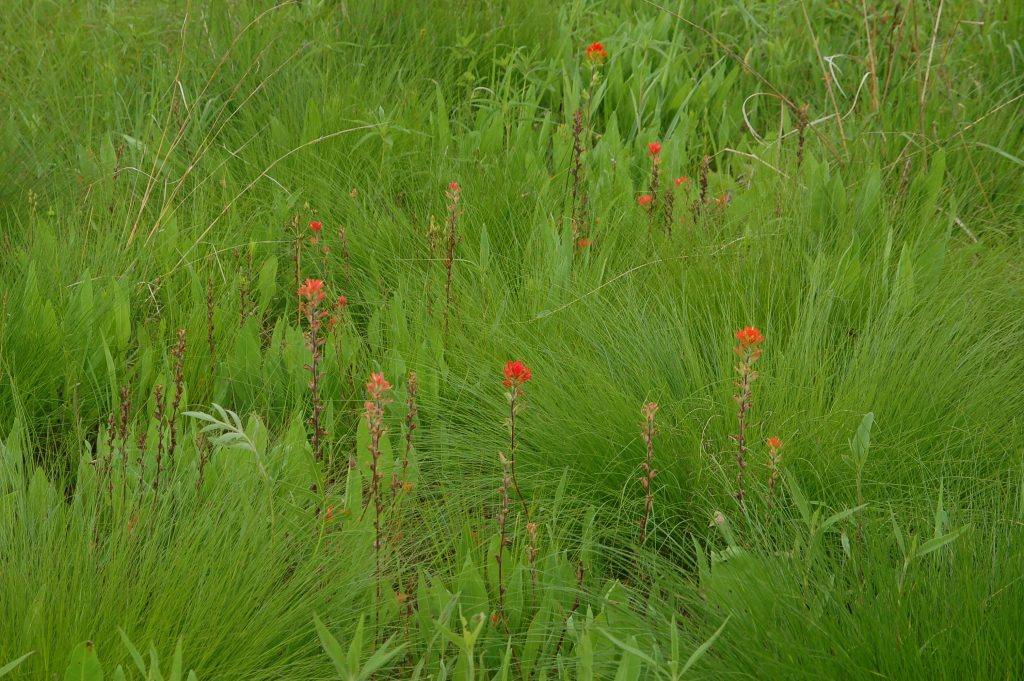Grigsby Prairie is Citizens for Conservation’s top prairie restoration. All forty-four acres at Grigsby were donated to CFC by Ms. Peggy Richards. Ms. Richards, who named the preserve for her father who had farmed it for many years, wished to preserve the land as open space and particularly wanted to see the grassland birds that inhabited her hay meadows remain.
Soon after we received the land (which Mrs. Richards donated as several parcels over the years), CFC decided that it was the ideal site for our first prairie reconstruction. Very little native vegetation remained on the site except for a fringe of trees along the property boundary along Buckley and Oak Knoll roads.
Thirty-three years ago CFC took the first steps toward restoration by cutting the brush (mainly European buckthorn, box elder and black locust) that had grown up in the unmown hayfields; five parcels were plowed, disked and planted with a mix of prairie seeds; plugs of three species (hoary puccoon, shooting star and prairie phlox) rescued from a construction site along the railroad tracks were transplanted in the fields.
Progress in the early days was slow. Tom Vanderpoel, director of restoration at the time, noticed that annual weeds grew up in the plowed fields and suppressed the germination and survival of the prairie plants. CFC no longer plows any of its restoration sites. Now we sow the seed directly into the fields or brush removal sites, and we continue to overseed all of the established areas.
A big step in restoring the native plants was the establishment of four serial wetlands. These engineering projects were funded through the United States Army Corps of Engineers wetland mitigation program in which real estate developers pay the cost of creating wetlands in natural areas to mitigate the loss of wetlands on their development sites.
In a mitigation project, first we break any agricultural drain tiles and saturate the land; then we re-contour the land and remove the tillage silt that had filled the wetlands; finally, we plant plugs and spread seed of marsh plants to stabilize the banks. The result is an area with gradual slope that allows a whole range of habitats to thrive. At Grigsby, the land climbs slowly from a shallow pond with marsh plants like hard-stemmed bulrush and blue flag iris, to sedge meadow with tussock sedge and swamp milkweed, to wet prairie with prairie cord grass and native prairie loosestrife. The habitats merge seamlessly with the restored prairie of big bluestem and prairie dock.
We greatly expand plant diversity as we create just the right habitats. Wetlands are extremely valuable as a practical matter because they store and clean storm water and allow groundwater recharge. We have a huge population of amphibians in the ephemeral wetlands because predatory fish cannot survive the periodic droughts that empty the ponds in the late summer and early fall. Migrant and nesting birds avail themselves of this diverse restored habitat. For example, marsh wrens nest in the emergent vegetation while sedge wrens nest in the sedge meadows. A typical degraded cattail marsh loses the sedge wrens. Another rare animal taking advantage of the wetland restoration is the black dash butterfly whose sole larval food source is sedge.
All of these restoration techniques — brush cutting, controlled burns, plant rescues, wetland reconstruction, overseeding, not to mention weed pulling and destruction of super invaders like reed canary grass with herbicide — have teamed up with Grigsby’s rolling topography and secluded setting to create a scenic oasis.

Indian paintbrush with prairie dropseed at Grigsby Prairie.
When is the best time to visit Grigsby? In mid-May, spring prairie flora (which is very difficult to establish) puts on a great display with the lavender of shooting stars, the scarlet of Indian paintbrush and the pumpkin orange of hoary puccoon. In early July the mesic prairie peaks with snow white wild quinine, gold prairie coreopsis and royal purple leadplant.
The wetlands peak in August with ironweed, spotted Joe Pye weed and sweet black-eyed Susan; at the same time the prairie/woodland border along Buckley Road is lovely with purple Joe Pye Weed and all the monarch, tiger Swallowtail and great-spangled fritillary butterflies the flowers attract. Then again, September is great with the gentians, asters, goldenrods and ladies tresses orchids blooming among the beautiful and colorful grasses and forbs. Come to think of it, any time of the year is worth a trip to Grigsby Prairie.
So many native plants are so well established at this preserve that it has become CFC’s top seed harvesting location. We use the seeds we collect at Grigsby to establish and enrich additional prairies at our other preserves and at preserves managed by our partner organizations.

